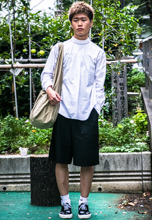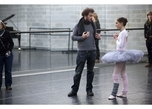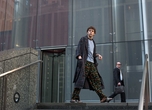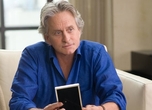Wes Anderson: interview
Fantastic Mr Fox was a huge undertaking. The director reveals all

Posted: Tue Mar 08 2011
Casually departing the world of live-action filmmaking, Wes Anderson's stop-motion retelling of Roald Dahl's much-loved children's book, Fantastic Mr Fox was a huge project. Dave Calhoun met him in London to reminisce.
So you made Fantastic Mr Fox here, at a studio in East London?
Yes - but I wasn’t here for the whole shooting. I just came and went. I was in lots of different places, but we had a system set up so I could do what I needed to do from abroad.
Was the film your idea in the first place?
Yes, but about ten years ago. I first met with Felicity Dahl, Roald’s wife, in 2000 to talk about this project.
Did you always want it to be a stop-motion animated film?
Yes, that was the thing right from the beginning.
All your films, from Bottle Rocket (1994) to The Darjeeling Limited (2007) have been live action. Did you feel confident about directing stop-motion animation?
Well, I didn’t know anything about how you go about it, so I just assumed we’d figure it out.
I suppose being a director means a very different thing on an animated film.
I guess it’s different in every situation with animations too. A lot of animation directors are there on the set the whole time. But I’m just as interested in how we’re designing it as in how we’re staging it. Even when I was at the studio, I was sitting at my computer using the same system I used when I worked from home or wherever I was. I could see through the camera on each unit on the set through my computer.
The film feels old-fashioned, like the expression of a traditional craft. How much of a purist were you in making of it?
Nowadays, stop-motion movies are shot a bit differently to how they used to be. They used to use a special movie camera that shoots one or two frames at a time. The Aardman movies are two frame of the same set-up for most scenes. A movie like Coraline is one frame. But now they almost always shoot them digitally with a stills camera. The resolution is much higher than any digital movie camera even. The whole movie is shot like that and then it goes onto hard drives.
The set looks like it’s built from household materials, like towels or corduroy.
The grass is mostly made of towelling. We wanted to avoid as much digital stuff as we could. In fact, I’m not sure there’s anything made digitally in the movie. Sometimes we’ve combined things, two shots, but we tried to rely on the old techniques. We could have made smoke by shooting real smoke and putting it in digitally. But instead we made smoke out of cotton balls. The water is made of cling film.
If had been on set, what would I have seen?
Well, the main puppet of Mr Fox, for instance, is about 12 inches tall. There were smaller puppets too of him, depending on the action and shot. The biggest set was the size of a room, but the smallest was the size of this couch we’re sitting on.
When it comes to Mr Fox, you introduce a conflict between him being a wild animal and yet acting like a human – more of a conflict that’s in Dahl’s book.
Yeah, that’s our theme. His whole thing is that he likes being wild. Even though he’s well-dressed, it’s important for him to be a wild animal. But I think he means it metaphorically, somehow! [laughs] But it sounds silly saying it.
Were you not worried about placing American accents within an obviously English setting – villages, pubs, cider and all that?
We’d written the characters as Americans, without meaning to, so if an English person talked that way, it would have sounded silly. So our rule was that all the animals spoke like Americans – because having talking animals is already a fairly significant break with reality! The humans have British accents. Although one guy, a helicopter pilot, is South African.
Lots of the voices are those of your regulars – like Bill Murray and Jason Schwartzman – but George Clooney is new to your gang. When did he get involved?
Once we said, 'Right, we’re now going to make the movie', we went to him. He was my first choice.
Did he warm to the idea easily?
I think he thought it was wild and he was not sure if it was for children or adults, but he really liked it. He said, 'You guys will have to figure out who the audience is, but I’ll do it.'
Does it bother you if people wonder if it’s for kids or adults?
People ask me that, but I always considered that my favourite children’s movies are movies I still watch now. We intended for children to see it, but I never thought of it as something particularly tailored for children. It’s animated. It’s about talking foxes. It’s based on a Roald Dahl story. It’s going to be for children, but there’s no reason for us to limit ourselves.
It’s pretty clean, even if the characters use the word ‘cuss’ a lot. Which isn’t in Dahl’s book.
Yes, that’s true. No, that word is not in Dahl’s book.
How did you find directing voices? Was it just you and the actors in a room?
Well, a lot of the recording of the actors we did outdoors. We went to Connecticut, to a farm, and recorded with a group of actors and they just acted out the scenes. If it was a scene in the woods, we went to the woods. And the sound man was like a movie sound man with a boom mic. We did some scenes in Italy that way, too. Some things I would record in an apartment, some in a studio.
That pretty unusual, isn’t it?
We did the whole movie on location first, then later we did some of it again in the studio. I remember George Clooney in particular was very physical, he was doing somersaults and everything.
You wrote this with Noah Baumbach, whose film The Squid and the Whale you produced. Dahl’s original book is very short and simple, so what were your and Noah’s main ideas for expanding it?
I had an idea for a section that would come before what was in the book – Mr Fox would move his family to a new place and buy a tree to live in and there would be attorneys and a real estate agent. Then Noah and I fleshed out a larger cast, too. The book doesn’t have that many characters that are defined: Mr Fox is there very solidly, and the farmers are very vivid, but there aren’t enough other characters for a whole feature, not for this one anyway. Then Noah and I came up with another section about what would happen after what’s in the book. We just sat together, taking it step by step. During the making of the film, there were some new scenes I added while we were shooting, too. I think that always happens with animated films – they take so long that they evolve during that time, too.
Fantastic Mr Fox opens across Japan on March 19
Tweets
- About Us |
- Work for Time Out |
- Send us info |
- Advertising |
- Mobile edition |
- Terms & Conditions |
- Privacy policy |
- Contact Us
Copyright © 2014 Time Out Tokyo














Add your comment